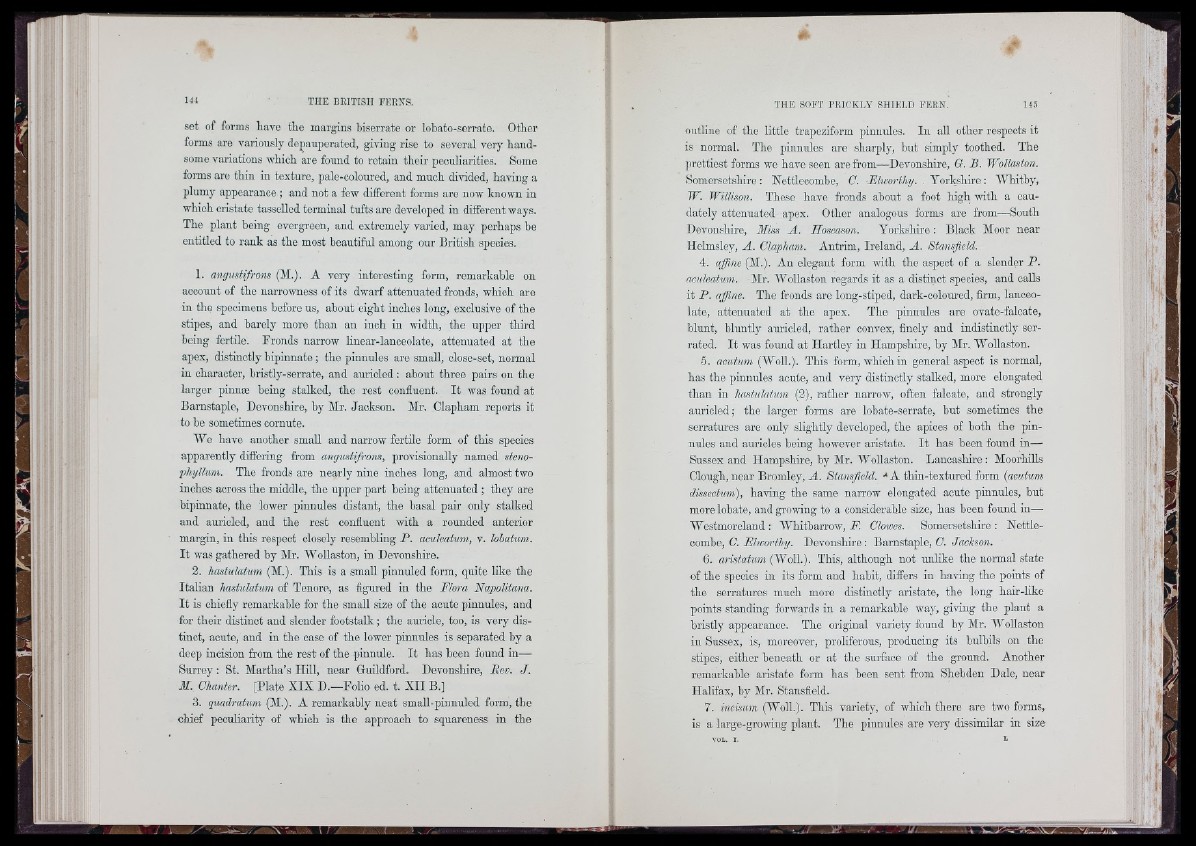
set of forms have the margins biserrate or lobato-serrate. Other
forms are variously depauperated, giving rise to several very handsome
variations which are found to retain their peculiarities. Some
forms are thin in texture, pale-oolourod, and much divided, having a
plumy appearance ; and not a few different forms are now known in
which cristate tasselled terminal tufts aro developed in different ways.
The plant being evergreen, and extremely varied, may perhaps be
entitled to rank as tho most beautiful among our British species.
1. angmfifrons (M.). A very interesting form, remarkable on
account of the narrowness of its dwarf attenuated fronds, which are
in the specimens before us, about eight inches long, exclusive of the
stipes, and barely moro than an inch in width, tho upper third
boing fertile. Fronds narrow linoar-lanceolate, attenuated at the
apex, distinctly bipinnate ; the pinnules arc small, close-set, normal
in oharaoter, bristly-serrate, and auricled : about three pairs on the
larger pinnæ being stalked, the rest confluent. I t was found at
Barnstaple, Devonshire, by Mr. Jackson. Mr. Clapham reports it
to be sometimes cornute.
We have another small and narrow fertile form of this species
apparently differing from amjiistifrons, provisionally named steno-
phylhwi. The fronds aro nearly nine inches long, and almost two
inches across the middle, the upper part being attenuated ; they are
bipinnate, the lower pinnules distant, the basal pair only stalked
and auricled, and the rest confluent with a rounded anterior
margin, in this respect closely resembling P . aculeatum, v. lobatum.
I t was gathered by Mr. WoUaston, in Devonshire.
2. hastulatum (M.). This is a small pinnuled form, quite like tho
Italian hastulatum of Tonore, as figured in the Flora Napolitana.
I t is chiefly remarkable for the small size of the acute pinnules, and
for their distinct and slender footstalk ; the auricle, too, is very distinct,
acute, and in the case of the lower pinnules is separated by a
deep incision from the rest of the pinnule. I t has been found in—
Surrey : St. Martha’s Hill, near Guildford. Devonshire, Rev. J.
M. Chanter. [Plate X IX D.—Folio ed. t. X II B.]
3. quadratum (M.). A remarkably neat small-pinnnled form, the
chief peculiarity of which is the approach to squareness in the
outline of the little trapeziform pinnules. In all other respects it
is normal. The pinnules are sharply, but simply toothed. The
prettiest forms we have seen are from—Devonshire, O. B. Wollaston.
Somersetshire: Nettlecombe, C. Elworthy. . Yorkshire: Whitby,
W. WilKson. These have fronds about a foot high with a oau-
dately attenuated apox. Other analogous forms aro from—South
Devonshire, SEss A . Jloseason. Yorkshire: Black Moor near
Ilelmsley, A . Clapham. Antrim, Ireland, A . Stansfield.
4. affine (M.). An elegant form m th the aspect of a slender P .
aculeatum. Mr. Wollaston regards it as a distinct species, and calls
it P . affine. The fronds are long-stiped, dark-oolonred, firm, lanceolate,
attenuated at the apex. The pinnules are ovate-falcate,
blunt, bluntly auricled, rather convex, finely and indistinctly serrated.
I t was found at Hartley in Hampshire, by Mr. WoUaston.
5. acutum (Woll.). This form, which in general aspect is normal,
has the pinnules acute, and very distinctly stalked, moro elongated
than in hastulatum (2 ), rather narrow, often falcate, and strongly
auricled; tho larger forms are lobate-serrate, but sometimes the
serratures are only slightly developed, the apices of both tho pinnules
and auricles being however aristate. I t has been found in—
Sussex and Hampshire, by Mr. Wollaston. Lancashire: Moorhills
Clough, near Bromley, A . Stansfield. * A thin-textured form {acutum
dissectum), having the same narrow elongated acute pinnules, hut
more lobate, and growing to a considerable size, has been found in—
Westmoreland : Whitharrow, F. Clowes. Somersetshire : Nettle-
oombe, C. Ehcorthy. Devonshire: Barnstaple, C. Jachson.
6 . aristatum (Woll.). This, although not unlike the normal state
of the species in its form and habit, differs in having the points of
the serratures much more distinctly aristate, the long hair-like
points standing forwards in a remarkable way, giving the plant a
bristly appearance. The original variety found by Mr. WoUaston
in Sussex, is, moreover, proliferous, producing its bulbils on the
stipes, either beneath or at the surface of tho ground. Another
remarkable aristate form has been sent from Shebden Dale, near
Halifax, by Mr. Stansfiold.
7. incisum (Woll.). This variety, of which there are two forms,
is a large-growing plant. The pinnules are very dissimilar in size